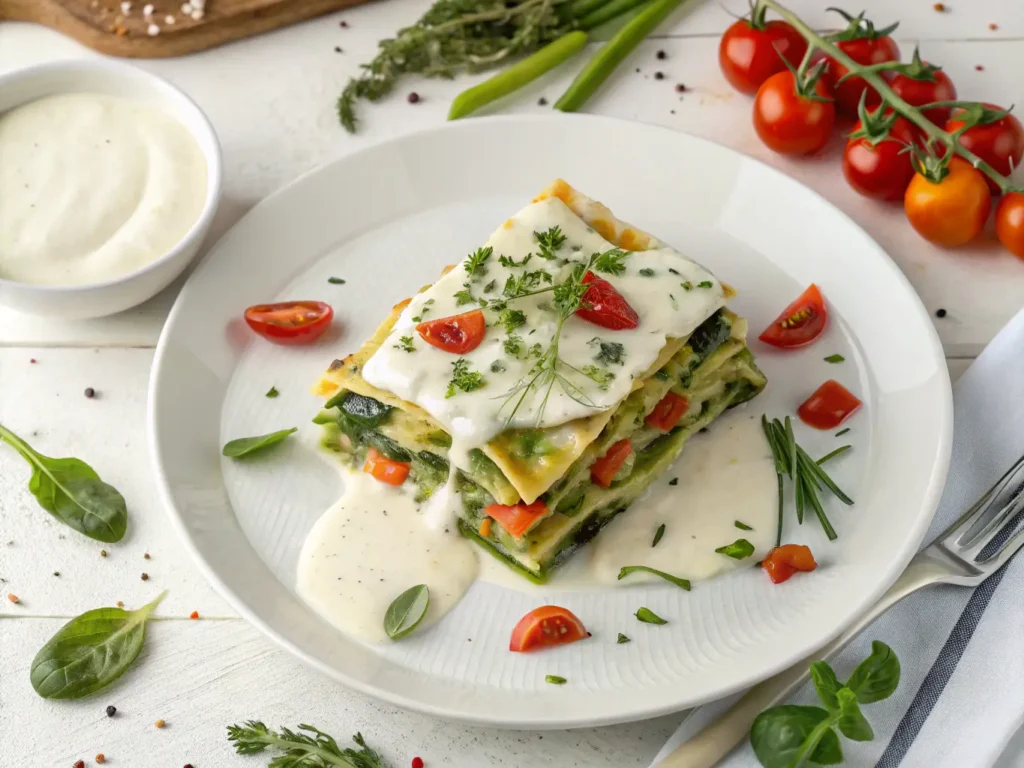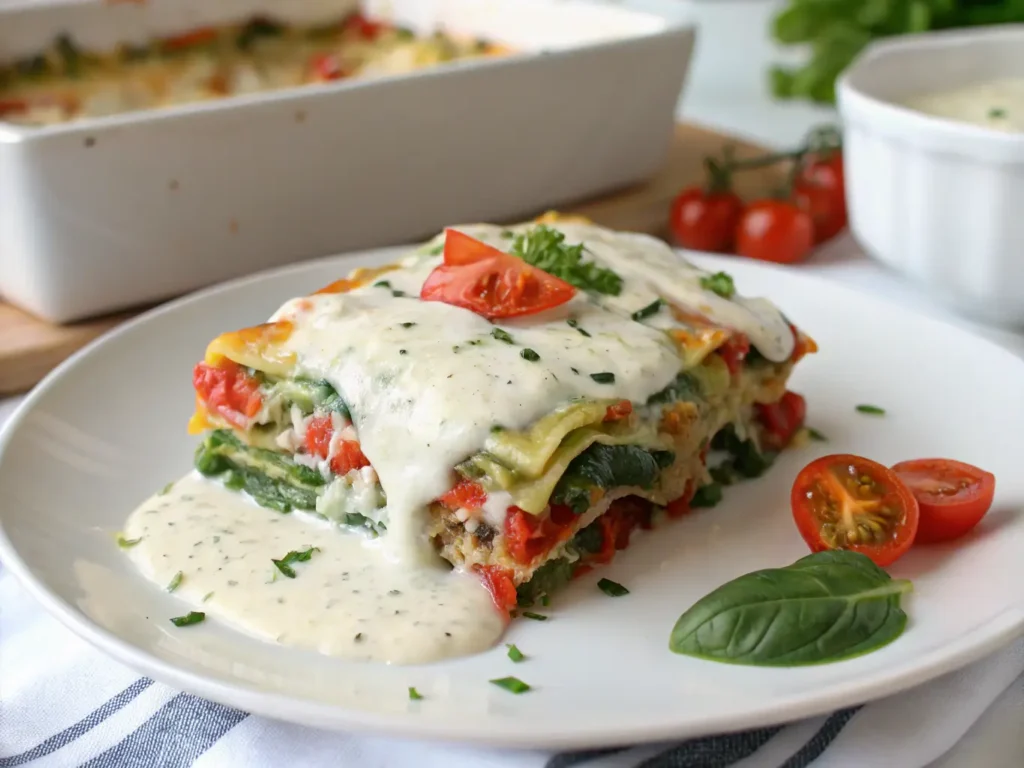Table of Contents
Vegetable lasagna with white sauce is a comfort food that blends creamy textures with the rich flavors of roasted vegetables, making it a perfect vegetarian alternative to the classic meat lasagna. This indulgent, yet wholesome dish delivers a satisfying blend of nutrients, flavors, and textures that will delight even the most discerning palates. The creamy white sauce (béchamel) adds a luxurious touch, elevating the dish to new heights of comfort.
Whether you’re preparing this dish for a family dinner, a festive gathering, or simply enjoying a nutritious homemade meal, vegetable lasagna with white sauce is versatile and easy to make. This recipe features layers of vegetables, rich white sauce, and cheese, all nestled between lasagna noodles, resulting in a decadent and satisfying meal. In this guide, we will break down every aspect of this dish, from ingredient selection and preparation techniques to variations and serving suggestions, ensuring that you can make the best vegetable lasagna with white sauce every time.
Introduction
Vegetable lasagna with white sauce is a dish that brings together the indulgence of traditional lasagna with a healthier, vegetarian twist. It’s packed with fiber, vitamins, and minerals from a variety of vegetables, making it a filling yet nutritious meal option. The rich and velvety béchamel sauce, typically made with butter, flour, and milk, adds a creamy texture that balances perfectly with the sweetness of vegetables like zucchini, spinach, and bell peppers.
What makes this lasagna truly special is its versatility—you can easily swap out ingredients based on what you have on hand or according to your dietary preferences. Whether you’re a fan of zucchini and mushrooms, or you prefer something with a bit more tang like tomatoes or carrots, the possibilities are endless. This dish is ideal for those looking for a comforting, creamy meal that doesn’t compromise on flavor, making it a crowd-pleaser at any gathering.
What is Vegetable Lasagna with White Sauce?
Origins of Lasagna
The origins of lasagna date back to ancient Rome, where flat sheets of dough were layered with meat or vegetables. The dish evolved through the centuries, with Italian cuisine refining it into the modern lasagna we know today. Traditionally, lasagna is made with a rich meat sauce and cheese. However, vegetable lasagna takes a lighter, more plant-forward approach, often using a combination of vegetables and cheese as its filling. The addition of béchamel sauce further enhances the texture, making it creamy without relying on heavy meats or rich tomato sauces.
A Perfect Vegetarian Option
Vegetable lasagna with white sauce is a fantastic vegetarian alternative to the traditional lasagna, providing the same comforting taste and hearty texture without the need for meat. By replacing meat with nutrient-dense vegetables, you maintain the integrity of a traditional lasagna while offering a healthy meal that’s suitable for vegetarians and vegans (with slight modifications). This recipe is also great for anyone looking to increase their vegetable intake while still enjoying a rich, indulgent meal.
Why White Sauce?
The role of béchamel sauce in vegetable lasagna is to create a creamy base that holds the dish together while imparting a luxurious richness. White sauce, typically made with butter, flour, and milk, is a classic French sauce that has found its way into many cuisines. When used in lasagna, it brings an added layer of creaminess and a mild richness, which complements the fresh flavors of the vegetables without overwhelming them. The combination of white sauce and cheese provides the perfect balance of texture and flavor, ensuring a smooth, comforting bite every time.

Ingredients for Vegetable Lasagna with White Sauce
Vegetables to Use
For this recipe, you want to use fresh, nutrient-rich vegetables that will provide great texture and flavor to your lasagna. Here are some of the best vegetables to incorporate:
- Zucchini: Zucchini is mild, tender, and has a soft texture that works perfectly in lasagna. Slice it thinly to avoid excess moisture.
- Spinach: Fresh spinach is a fantastic addition to vegetable lasagna. It wilts down and adds both color and nutrients, including iron and vitamins.
- Mushrooms: Mushrooms add an earthy flavor and meaty texture. Sauté them to release excess moisture before layering.
- Carrots: Thinly sliced carrots add natural sweetness and a bit of crunch, balancing the rich sauce and cheese.
- Bell Peppers: Bell peppers bring a bit of sweetness and crunch, adding vibrancy to the dish.
Feel free to swap or add other vegetables, such as eggplant, tomatoes, or broccoli, depending on your taste preferences or what’s in season.
Lasagna Noodles
The type of noodles you choose can affect both the texture and cooking time of your lasagna:
- Regular Lasagna Noodles: These traditional noodles require boiling before layering.
- Whole Wheat Lasagna Noodles: A healthier alternative with added fiber.
- Gluten-Free Noodles: For those with gluten sensitivities, gluten-free noodles made from rice or corn work well in this dish.
- No-Boil Noodles: Convenient and time-saving, no-boil noodles soften as the lasagna bakes, absorbing the white sauce.
Preparing the White Sauce
The béchamel sauce is a key component in making this lasagna extra creamy. To make it, you will need:
- Butter: The base of the sauce, providing richness.
- Flour: To thicken the sauce and create a smooth texture.
- Milk: The liquid that combines with the butter and flour to create the creamy base.
- Seasonings: A pinch of nutmeg, salt, and white pepper adds subtle warmth and enhances the flavor of the sauce.
Cheese Options
Cheese is an essential part of any lasagna. Here are some cheeses that complement the vegetable layers and white sauce:
- Mozzarella: The classic cheese for lasagna. It melts beautifully and gives a gooey, stretchy texture.
- Parmesan: Adds a sharp, nutty flavor and helps to bring out the other ingredients.
- Ricotta: Offers a creamy texture and slightly sweet flavor that works well with the vegetables.
- Cottage Cheese: A lighter alternative to ricotta, offering a similar creamy texture but with a lower fat content.
Seasonings and Herbs
A variety of herbs and spices will help bring out the flavors of your vegetables and white sauce:
- Garlic: Adds depth and aromatic flavor.
- Oregano: A classic herb in Italian cooking that pairs wonderfully with the savory flavors.
- Basil: Fresh basil provides a fragrant, herbal kick that complements the creamy sauce.
- Thyme: Adds a subtle earthy flavor that enhances the richness of the dish.
Equipment Needed for Preparing the Recipe
To make the perfect vegetable lasagna with white sauce, you’ll need a few basic kitchen tools.
Baking Dish
A 9×13-inch baking dish is typically the best size for lasagna. You can use glass, ceramic, or metal dishes, depending on your preference. Glass dishes allow you to see the layers clearly, while ceramic dishes provide excellent heat retention.
Cooking Tools
- Saucepan: For making the béchamel sauce.
- Whisk: To ensure the white sauce is smooth and lump-free.
- Spatula: For spreading the sauce and layering the vegetables evenly.
- Mandoline Slicer (optional): For uniform vegetable slices, especially when using zucchini and carrots.
Step-by-Step Recipe for Vegetable Lasagna with White Sauce
Preparing the Vegetables
- Sauté the Vegetables: Start by sautéing the mushrooms, zucchini, and carrots in a bit of olive oil. Cook until soft, and make sure to release any excess moisture from the mushrooms. You can also roast the vegetables in the oven for extra flavor, especially the zucchini and bell peppers.
- Wilt the Spinach: In a separate pan, sauté the spinach until it wilts. If using frozen spinach, make sure to drain any excess water before adding it to the lasagna.
Making the White Sauce
- Melt the Butter: In a saucepan, melt butter over medium heat.
- Add the Flour: Stir in the flour and cook for about 2 minutes to form a roux. Be sure to stir constantly to prevent any lumps.
- Gradually Add Milk: Slowly pour in milk, whisking constantly to ensure the mixture remains smooth. Bring the sauce to a simmer.
- Season the Sauce: Add salt, white pepper, and a pinch of nutmeg. Stir until the sauce thickens to a creamy consistency. Remove from heat.
Layering the Lasagna
- Start with Sauce: Spread a thin layer of béchamel sauce at the bottom of the baking dish.
- Add Noodles: Place a layer of lasagna noodles over the sauce. If using no-boil noodles, ensure they are well-covered with sauce.
- Layer Vegetables: Add a layer of the sautéed and wilted vegetables, followed by a sprinkle of mozzarella and Parmesan cheese.
- Add More Sauce: Spread another layer of béchamel sauce on top of the vegetables.
- Repeat Layers: Continue layering noodles, vegetables, sauce, and cheese until the dish is filled, finishing with a top layer of sauce and cheese.
Baking the Lasagna
- Preheat the Oven: Preheat your oven to 375°F (190°C).
- Bake the Lasagna: Cover the lasagna with aluminum foil and bake for 30 minutes. After 30 minutes, remove the foil and bake for an additional 15-20 minutes, or until the top is golden and bubbly.
Resting Before Serving
Allow the lasagna to rest for about 10-15 minutes after removing it from the oven. This step helps the lasagna set, making it easier to slice.
Tips for Perfect Vegetable Lasagna with White Sauce
Balancing Flavors
Make sure to season each layer of vegetables with herbs and salt. Layering the seasoning helps each component of the lasagna shine.
Preventing a Soggy Lasagna
To avoid watery layers, be sure to pre-cook your vegetables and drain excess moisture. Avoid overloading with sauce, and use a thicker béchamel to help prevent sogginess.
Choosing the Right Cheese Ratio
Balance the richness of the béchamel sauce with just the right amount of cheese. Too much cheese can overwhelm the vegetables, while too little can make the lasagna dry.

Variations of Vegetable Lasagna with White Sauce
Vegan Vegetable Lasagna
For a vegan version, use plant-based milk (such as almond or oat milk), dairy-free cheese, and vegan béchamel (using coconut milk and plant-based butter).
Gluten-Free Version
If you need a gluten-free option, replace regular noodles with gluten-free pasta or even zucchini slices for a low-carb alternative.
Mediterranean-Inspired Lasagna
Add artichokes, black olives, and feta cheese for a Mediterranean twist that complements the creamy white sauce.
Protein-Packed Lasagna
For added protein, consider incorporating lentils, chickpeas, or tofu into your vegetable layers.
Serving Suggestions for Vegetable Lasagna with White Sauce
Side Dishes
Pair the lasagna with garlic bread, roasted asparagus, or a Caesar salad for a complete meal.
Beverage Pairings
Serve with a light white wine like Sauvignon Blanc, or go for something refreshing like sparkling water or herbal tea.
Garnishes
Finish the dish with a sprinkle of fresh basil, parsley, or a drizzle of olive oil before serving for extra flavor.
Health Benefits of Vegetable Lasagna with White Sauce
Nutritional Value of Vegetables
The variety of vegetables in the lasagna provides essential vitamins, fiber, and antioxidants, which support overall health.
Balanced Meal
Lasagna combines carbs, protein, and fats for a well-rounded meal that satisfies hunger while providing lasting energy.
Customizing for Dietary Needs
You can make this recipe lighter by using low-fat cheese or reducing oil in the béchamel sauce without sacrificing flavor.
Common Mistakes to Avoid
Overloading the Layers
Too much sauce or too many vegetables can lead to uneven cooking and sogginess. Layer lightly for the best results.
Not Pre-Cooking Vegetables
Avoid using raw vegetables in your lasagna. Always pre-cook or sauté them to eliminate excess moisture and ensure even texture.
Skipping the Resting Step
Allow your lasagna to rest before slicing to ensure the layers set properly.
FAQs
Can I make vegetable lasagna ahead of time?
Yes, vegetable lasagna can be prepared a day in advance and stored in the refrigerator. Simply bake it when you’re ready to serve.
What is the best way to store and reheat lasagna?
Store leftovers in an airtight container in the refrigerator for up to 3 days. Reheat in the oven at 350°F for about 20 minutes or until heated through.
Can I freeze vegetable lasagna with white sauce?
Yes, vegetable lasagna can be frozen for up to 3 months. Let it cool completely before wrapping it in foil or plastic wrap.
What are good substitutes for béchamel sauce?
You can use cream cheese, ricotta, or cream as a substitute for béchamel sauce.
How do I make this recipe vegan?
Use plant-based cheese, vegan milk, and a dairy-free béchamel to make this recipe vegan-friendly.
Can I use frozen vegetables?
Yes, frozen vegetables work well in lasagna, but be sure to thaw and drain them before using to avoid excess moisture.
Conclusion
Vegetable lasagna with white sauce is a delicious, creamy, and nutritious dish that is perfect for any occasion. Whether you’re serving it as a hearty family dinner or bringing it to a potluck, this dish will impress everyone with its flavor and versatility. With the right ingredients and techniques, you can create the ultimate lasagna that’s perfect for vegetarians and non-vegetarians alike. Give this recipe a try today and enjoy a comforting, indulgent meal that’s sure to become a favorite.

